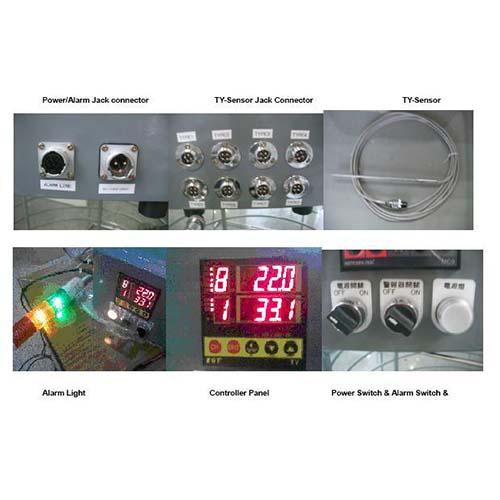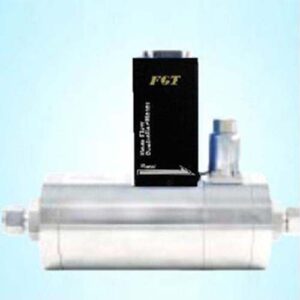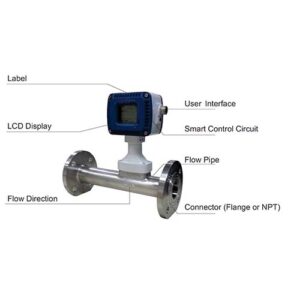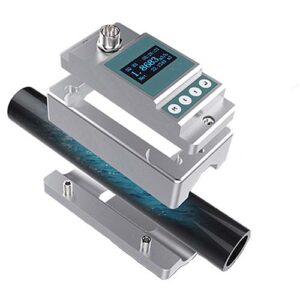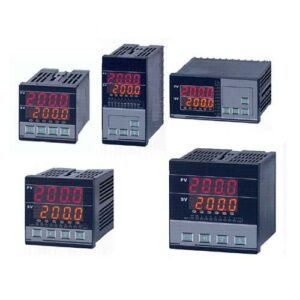FGT think your best choice in the future
System Integration Designers in FGT
TY04-08 Type: multi-channel temperature controller with display
- Support a variety of composite temperature control and monitoring functions.
- Portable and easy to move: using quick connectors (with fool-proof design) is easy to operate
- The function of setting all sensing points at one time.
- The alarm can be forcibly turned off by the panel, and has the police officer to confirm the setting. Elimination function
- Common voltage design: AC90~240V
- Support RS485/Wifi+AIoT function.
- Description
- Additional information
- Technical Specifications
- Application field
- Dimensions
- Order model
- Inquire now
- Support a variety of composite temperature control and monitoring functions.
- Portable and easy to move: using quick connectors (with fool-proof design) is easy to operate
- The function of setting all sensing points at one time.
- The alarm can be forcibly turned off by the panel, and has the police officer to confirm the setting. Elimination function
- Common voltage design: AC90~240V
- Support RS485/Wifi+AIoT function.
PID and Programmable Temperature Controllers
Introduction to PID Controller Temperature Control
As the name suggests, a temperature controller is an instrument used to control temperature. A temperature controller takes input from a temperature sensor and has an output connected to a control element such as a heater or fan.
To precisely control process temperature without extensive operator involvement, temperature control systems rely on a controller that accepts as input a temperature sensor such as a thermocouple or RTD. It compares the actual temperature to the desired control temperature or setpoint and provides the output to the control element. The controller is part of the overall control system, and the entire system should be analyzed when selecting a suitable controller. When choosing a controller, the following should be considered:
- Type of input sensor (thermocouple, RTD) and temperature range
- Desired output type (electromechanical relay, SSR, analog output)
- Desired control algorithm (on/off, proportional, PID)
- Number and type of outputs (heating, cooling, alarm, limit)
What are the different types of controllers and how do they work?
There are three basic types of controllers: on/off, proportional and PID. Depending on the system to be controlled, the operator will be able to use one type or the other to control the process.
On/Off Control
Switch controllers are the simplest form of temperature control equipment. The output of the device is on or off, with no intermediate states. The switch controller switches the output only when the temperature exceeds the set point. For heating control, the output turns on when the temperature is below the set value and turns off when the temperature is above the set value. As the temperature exceeds the setpoint to change the output state, the process temperature will continuously cycle from below the setpoint to above and back down. In situations where such cycling occurs rapidly, a switching differential or "hysteresis" is added to the controller operation to prevent damage to the contactors and valves. This difference requires the temperature to exceed the setpoint by a certain amount before the output will turn off or on again. If cycling above and below the set point occurs very quickly, the on-off differential prevents the output from "chattering" or switching in rapid succession. On-off control is often used when precise control is not required, in systems that cannot handle frequent switching of energy on and off, the mass of the system is so large that the temperature changes very slowly, or for temperature alarms. A special type of switch control used for alarms is a limit controller. The controller uses a latching relay that must be manually reset and used to shut down the process when a certain temperature is reached.
Proportional control
Proportional control is designed to eliminate the looping associated with on-off control. As the temperature approaches the setpoint, the proportional controller reduces the average power supplied to the heater. This will slow down the heater so that it does not exceed the set point, but will approach the set point and maintain a stable temperature. This scaling can be done by turning the output on and off in short time intervals. This "time ratio" changes the ratio of "on" time to "off" time to control temperature. Proportional action occurs within a "proportional band" around the set temperature. Outside this band, the controller acts as an on/off unit, with the output fully on (below the band) or fully off (above the band). However, in this frequency band, the difference between the output and the set value is equal to the on and off of the output. At the set point (midpoint of the proportional band), the output on/off ratio is 1:1; that is, the on and off times are equal. If the temperature is farther from the set point, the on and off times will vary proportional to the temperature difference. If the temperature is below the set point, the output will take longer; if the temperature is too high, the output will be off for a longer time.
PID control
The third controller type provides integral and derivative control or proportional control of PID. The controller combines proportional control with two additional adjustments, which help the unit automatically compensate for changes in the system. These adjustments (integral and derivative) are expressed in time-based units; their inverses are RESET and RATE, respectively. The proportional, integral and derivative terms must be individually tuned or "tuned" to a specific system using trial and error. It provides the most precise and stable control of the three controller types and is best suited for systems with relatively small masses that respond quickly to changes in energy added to the process. recommended in
| Application | temperature, equipment |
|---|---|
| Types of | Electronic |
| Installation method | Panel Mounting |
| Output method | digital, switch, analog |
Technical Specifications
| model | TY04 | TY04R | TY08 | TY08R |
| Sensing points | 4 | 4 | 8 | 8 |
| input type | TC,RTD,DCV(Refer to Input type & Range Code) | |||
| Standard contact | ±0.1 % ℃(0~50 ℃) | |||
| input range | Refer to Inoput Type * Range code | |||
| memory storage | Memory Backup By EEPROM,Life span of EEPROM:100,000 writing possible,Save Data for Over 10 years | |||
| control type | On/Off,P,PI,PD,PID control | |||
| Contact input | Direct,Reverse On:less than 2KΩ,Off:over 15KΩ | |||
| Operating environment | Ambient Temp.:0~50 ℃ | |||
| Ambient Humi.:20~85 % RH | ||||
| communication function | No | RS485/Wifi+AIoT | No | RS485/Wifi+AIoT |
| Supply voltage | AC 100~240V, 50/60Hz | |||
Application field
What is a PID controller
A proportional-integral-derivative controller (PID controller or three-level controller) is a control loop mechanism that uses feedback and is widely used in industrial control systems and various other applications that require continuous modulation control. The PID controller continuously calculates the error value as the difference between the desired set point (SP) and the measured process variable (PV) and corrects it based on proportional, integral and derivative terms (denoted as P, I and D respectively), hence the name .
In fact, it automatically makes accurate and responsive corrections to the control functions. An everyday example would be cruise control on a car, where climbing a hill will reduce speed if only constant engine power is applied. The PID algorithm of the controller restores the measured speed to the desired speed with minimal delay and overshoot by increasing the power output of the engine.
The earliest theoretical analysis and practical application was in the field of ship automatic steering systems developed in the early 1920s. It is then used in automatic process control in manufacturing, widely used in pneumatic controllers and electronic controllers. Today, the PID concept is commonly used in applications that require precise and optimized automatic control.
PID controller application
In theory, a controller can be used to control any process that has a measurable output (PV), a known ideal value for that output (SP), and a process input (MV) that will affect the associated PV. Controllers are used in industry to regulate temperature, pressure, force, feed rate, [15] flow rate, chemical composition (component concentration), weight, position, speed, and almost every other measured variable that exists.
1. Environmental Control
2. Smart Manufacturing Automation
Dimensions
| model | TY04 | TY04R | TY08 | TY08R |
| Sensing points | 4 | 4 | 8 | 8 |
| input type | TC,RTD,DCV(Refer to Input type & Range Code) | |||
| Standard contact | ±0.1 % ℃(0~50 ℃) | |||
| input range | Refer to Inoput Type * Range code | |||
| memory storage | Memory Backup By EEPROM,Life span of EEPROM:100,000 writing possible,Save Data for Over 10 years | |||
| control type | On/Off,P,PI,PD,PID control | |||
| Contact input | Direct,Reverse On:less than 2KΩ,Off:over 15KΩ | |||
| Operating environment | Ambient Temp.:0~50 ℃ | |||
| Ambient Humi.:20~85 % RH | ||||
| communication function | No | RS485/Wifi+AIoT | No | RS485/Wifi+AIoT |
| Supply voltage | AC 100~240V, 50/60Hz | |||
Order model
| Ordering Information | ||||||||||
| TY | coding | channel type | ||||||||
|
|
4 | 4 o'clock channel (standard type) | ||||||||
| 8 | 8 o'clock channel | |||||||||
|
|
coding | input type | ||||||||
| K0 | K-Type :-200~1370(℃) | |||||||||
| K1 | K-Type:-199.9~999.9(℃) | |||||||||
| J0 | J-Type :-200~1200(℃) | |||||||||
| J1 | J-Type:-199.9~999.9(℃) | |||||||||
| R0 | R-Type: 0~1700(℃) | |||||||||
| R1 | R-Type: 0.0~999.9(℃) | |||||||||
| S0 | S-Type: 0~1700(℃) | |||||||||
| S1 | S-Type: 0.0~999.9(℃) | |||||||||
| B0 | B-Type: 0~1800(℃) | |||||||||
| B1 | B-Type: 0.0~999.9(℃) | |||||||||
| E0 | E-Type :-200~1000(℃) | |||||||||
| E1 | E-Type:-199.9~999.9(℃) | |||||||||
| N0 | N-Type :-200~1300(℃) | |||||||||
| N1 | N-Type:-199.9~999.9(℃) | |||||||||
| T0 | T-Type:-199.9~400.0(℃) | |||||||||
| W0 | W-Type:0~2300(℃) | |||||||||
| A0 | A-Type: 0~1390(℃) | |||||||||
| U0 | U-Type:-199.9~600.0(℃) | |||||||||
| L0 | L-Type:-199.9~900.0(℃) | |||||||||
| D0 | Pt100-Type :-199.9~600.0(℃) (standard type) | |||||||||
| P0 | JPt100-Type :-199.9~500.0(℃) | |||||||||
| V0 | Voltage-Type :-199.9~999.9(℃) for 0~5V | |||||||||
| V1 | Voltage-Type :-199.9~999.9(℃) for1~5V | |||||||||
| V2 | Voltage-Type :-199.9~999.9(℃) for 1~10V | |||||||||
|
|
coding | Alert Type | ||||||||
| N | without | |||||||||
| 1 | With 1 point alarm (standard type) | |||||||||
| 2 | With 2 point alarm | |||||||||
| 3 | There is a 3 point alarm | |||||||||
|
|
coding | Communication type | ||||||||
| N | None (standard type) | |||||||||
| 1 | With RS485 | |||||||||
| 2 | Wifi AIoT | |||||||||
|
|
coding | Supply voltage | ||||||||
| A | AC 90~240V | |||||||||
|
|
coding | Logo | ||||||||
| F | FGT label (standard type) | |||||||||
| C | Customized brand | |||||||||
|
|
||||||||||
| TY | Complete order model | |||||||||
| *Note: All models use supply voltage (AC 90~240 /50W) | ||||||||||
| *Note: The number of orders placed with a customized brand requires an annual purchase order of more than 100 sets | ||||||||||

